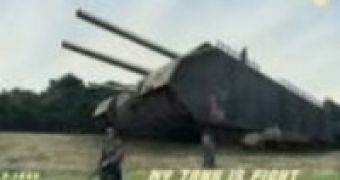Who can name the biggest tank in history?
Of, course, it was built (or at least designed on paper) during World War II, considered to be the Golden Age of tanks.
But did you know that the first tank in history was designed, though never actually built, by Leonardo Da Vinci?
It was an armored war vehicle capable of moving in any direction and bristling with guns. To be effective, an element of these tanks would probably have had an escort of handgun-armed loose-order infantry, much as the foot troops that accompanied Elephants in Indian armies, or the handgunners and crossbowmen in Hussite armies staying with their Warwagons.
OK, let's get back to the biggest tank.
Was it the German King Tiger?
The Panzerkampfwagen VI Ausf. B was a German heavy tank of the Second World War. It was also known as Sonderkraftfahrzeug 182 (Sd. Kfz. 182), or informally Tiger II or K?nigstiger (German: Bengal Tiger, often literally translated as King Tiger) and by the British as Royal Tiger.
It weighed 69.8 tonnes (154 000 lbs), was 7.62 m (25 ft) long, was protected by 150 to 180 mm of frontal armor, and was armed with the 88 mm KwK 43 L/71 gun.
Not big enough
Then, maybe the Panzerkampfwagen VIII Maus (Sd.Kfz 205), a German super-heavy tank design, and the heaviest tank to reach the complete working prototype stage in World War II. The first prototype, to be ready in 1943 was initially to receive the name Mammut (Ger. "Mammoth"), then its name was changed to "Maus" (Mouse). It weighed 188 tonnes, was 10.09 m (35 ft) long and its armament was a 128 mm cannon with a coaxial 75 mm gun and steel armor ranging from 60-240 mm.
Still not big enough.
The Landkreuzer P. 1000 Ratte (Rat) was to have been an extremely large tank, designed in 1942 with the approval of Hitler, and then canceled in early 1943. At over 1800 metric tons (One million, eight hundred thousand kilograms, or 3.96 million pounds and as much as an Russian Navy Ognevoy class destroyer), the P-1000 would have been roughly ten times heavier than the Panzer VIII Maus, the largest tank ever actually built.
Its primary weapons would have been two 280 mm guns, a single 128 mm gun, eight 20 mm Flak 38 anti-aircraft guns and two 15 mm Mauser MG 151/15 guns.
It would have been 35 m (115 ft) and would have had 150 mm to 360 mm of armor plating, and a crew of 20 men to operate it.
It would have been equipped with six 1.2-meter tracks with three tracks per side. Its power would have come from two MAN 24 cylinder Diesel marine engines with 8500 hp each or eight Daimler-Benz 20 cylinder Diesel marine engines with 2000 hp each to achieve the 16000 hp needed to move this tank.
Yeah, pretty big, but still...
The Landkreuzer P. 1500 Monster was a preprototype ultraheavy tank meant as a mobile platform for the Krupp 800mm Schwerer Gustav artillery piece, in fact, a mobile grand cannon.
If completed it would have easily surpassed the Panzer VIII Maus, and even the extremely large Landkreuzer P. 1000 Ratte in size, though it would only have enough power to reach up to speeds of 10-15 kph.
It would have been 42 m (138 ft) long, would have weighed 2500 tonnes, with a 250 mm hull front armor, 4 MAN U-boat (submarine) diesel engines, and an operating crew of over 100 men.
It would have been so heavy that it would have cracked pavement behind it and it would not have been able to cross bridges.
The main armament would have been an 800 mm Dora/Schwerer Gustav K (E) railway gun 10 times bigger in diameter than modern tank cannons, and a secondary armament of two 150 mm sFH 18/1 L/30 howitzers and multiple 15 mm MG 151/15 machine guns.
It's a good thing World War II ended when it did, because if it had lasted for another two or three years, no army in the world could have withstood the immense firepower of these giant tanks.

 14 DAY TRIAL //
14 DAY TRIAL //